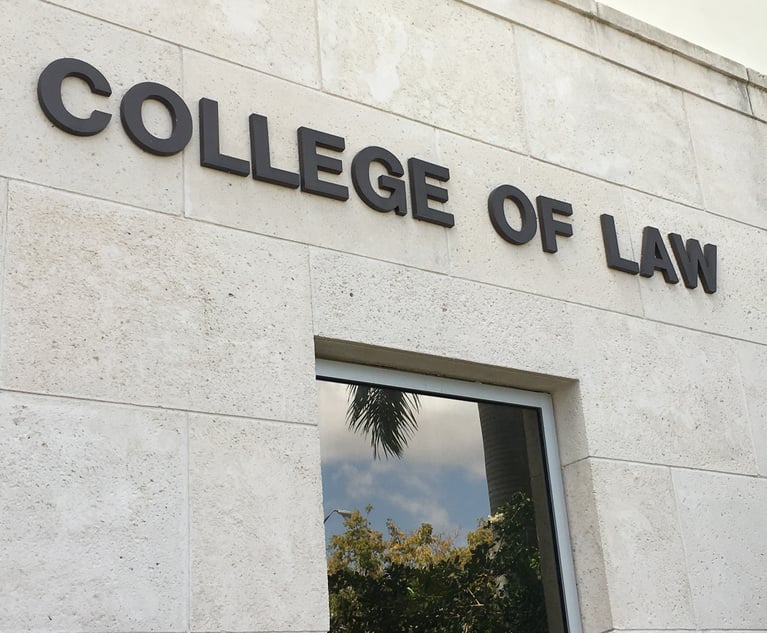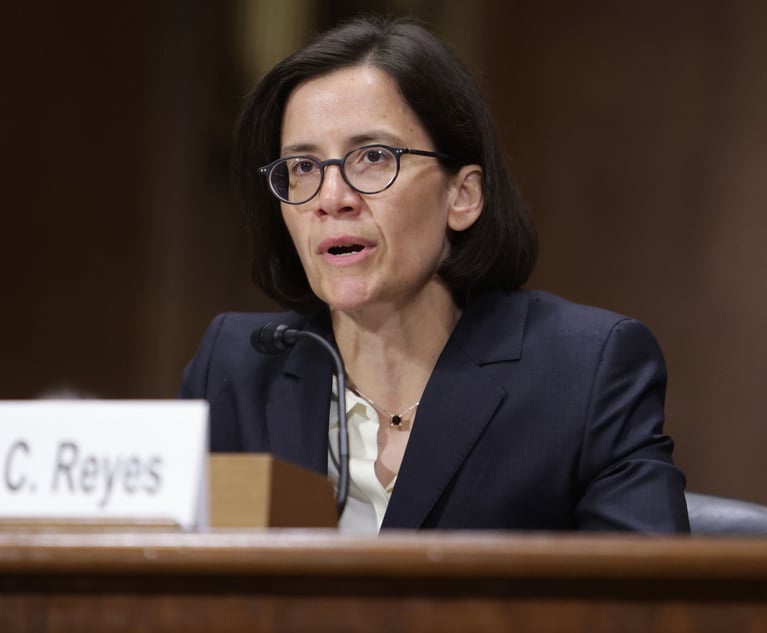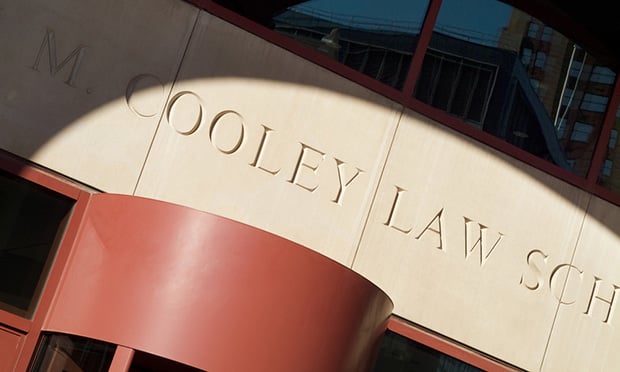Cooley Law Drops ABA Accreditation Suit, but Others Remain
Western Michigan University Cooley Law School has dismissed its accreditation suit against the American Bar Association, saying it had achieved its primary goals outside of court.
November 01, 2018 at 11:40 AM
5 minute read
The stack of law school accreditation suits the American Bar Association is facing is one shorter today.
Western Michigan University Cooley Law School on Wednesday dismissed its suit against the ABA, saying there was little point in continuing the litigation when it had largely achieved its aims outside of court.
The move came a day after both parties met for a court-ordered settlement conference, and ends nearly a year of legal wrangling over how the ABA conducts its law school oversight. During the course of the suit, the ABA declared the school in full compliance with its standards and gave it the green light to open a branch campus in Kalamazoo, Michigan.
“On behalf of the law school, we are very happy to put this lawsuit behind us,” said Cooley Law Interim President Jeff Martlew in a statement. “The circumstances that led to the litigation have been largely resolved and there was simply no point in continuing. Importantly, we have had very cordial communication with representatives from the ABA Council on Legal Education and Admission to the Bar. WMU-Cooley is committed to pursuing a collaborative approach in working with the Council, to continue meeting ABA standards.”
ABA officials said they are also pleased to see the suit dropped.
“WMU-Cooley Law School has dismissed its lawsuit against the American Bar Association with prejudice,” said Barry Currier, the ABA's managing director for accreditation and legal education. “The ABA welcomes the end of this dispute and looks forward to continuing to serve the best interests of students and the public through the ABA law school accreditation process, which has repeatedly been upheld by courts and has been approved by the U.S. Department of Education.”
Cooley Law sued the ABA's Section of Legal Education and Admissions to the Bar in November 2017 after it was found to be out of compliance with rules requiring schools to only admit students who “appear capable” of graduating and passing the bar. The ABA also denied Cooley's request to open the Kalamazoo campus, which the Lansing, Michigan-based school had filed in 2016. (Cooley became affiliated with Kalamazoo-based WMU in 2014.)
The school asked the court to enjoin the ABA from enforcing the admissions standard until it could specify what Cooley needed to do to be in compliance, arguing that the standards are unlawfully vague and unevenly applied among schools.
In the meantime, the ABA's Accreditation Committee in April determined that Cooley had come back into compliance with the admissions standards. The ABA also later bestowed its blessing on the Kalamazoo branch campus—where students may take up to 60 credits. It opened this past September.
Court documents show that Cooley promised to admit only students whose undergraduate grade-point average predicts a law school GPA of 2.1, up from the previous 2.0 threshold. Moreover, students whose incoming academic credentials suggest they will achieve a law school grade-point average below 2.5 would be limited to taking no more than 12 credits a semester, or one less class than a typical course load.
“I am not at all surprised that Cooley has agreed to settle and withdraw the suit, given that the ABA essentially capitulated, giving Cooley almost everything they wanted, while extracting only extremely minor concessions in return,” said David Frakt, a Florida lawyer who has followed and blogged about the litigation.
While the Cooley suit is closed, the ABA still faces accreditation litigation brought by the Florida Coastal School of Law; Arizona Summit Law School; and the now-closed Charlotte School of Law, each of which are owned by the for-profit InfiLaw Corp. Those schools were each found to be out of compliance with the ABA standards, to varying degrees.
Arizona Summit's suit may be the next to go. School President Peter Goplerud told regulators in Arizona last week that it plans to drop its fight to hang on to its accreditation and close up once the ABA has signed off on its teach-out plan, which will allow the small number of students who remain to obtain their degrees.
This content has been archived. It is available through our partners, LexisNexis® and Bloomberg Law.
To view this content, please continue to their sites.
Not a Lexis Subscriber?
Subscribe Now
Not a Bloomberg Law Subscriber?
Subscribe Now
NOT FOR REPRINT
© 2025 ALM Global, LLC, All Rights Reserved. Request academic re-use from www.copyright.com. All other uses, submit a request to [email protected]. For more information visit Asset & Logo Licensing.
You Might Like
View All
Justified Termination Does Not Bar Associate Attorney From Unemployment Benefits, State Appellate Court Rules
5 minute read
Florida Law Schools Are Seeing a Bump in Applications for 2025, After Recent Declines at Flagship Schools
3 minute read
Federal Judge Warns of 'Serious Sanctions' on FDIC Over Document Retention
3 minute read
Hogan Lovells, Jenner & Block Challenge Trump EOs Impacting Gender-Affirming Care
3 minute readTrending Stories
Who Got The Work
J. Brugh Lower of Gibbons has entered an appearance for industrial equipment supplier Devco Corporation in a pending trademark infringement lawsuit. The suit, accusing the defendant of selling knock-off Graco products, was filed Dec. 18 in New Jersey District Court by Rivkin Radler on behalf of Graco Inc. and Graco Minnesota. The case, assigned to U.S. District Judge Zahid N. Quraishi, is 3:24-cv-11294, Graco Inc. et al v. Devco Corporation.
Who Got The Work
Rebecca Maller-Stein and Kent A. Yalowitz of Arnold & Porter Kaye Scholer have entered their appearances for Hanaco Venture Capital and its executives, Lior Prosor and David Frankel, in a pending securities lawsuit. The action, filed on Dec. 24 in New York Southern District Court by Zell, Aron & Co. on behalf of Goldeneye Advisors, accuses the defendants of negligently and fraudulently managing the plaintiff's $1 million investment. The case, assigned to U.S. District Judge Vernon S. Broderick, is 1:24-cv-09918, Goldeneye Advisors, LLC v. Hanaco Venture Capital, Ltd. et al.
Who Got The Work
Attorneys from A&O Shearman has stepped in as defense counsel for Toronto-Dominion Bank and other defendants in a pending securities class action. The suit, filed Dec. 11 in New York Southern District Court by Bleichmar Fonti & Auld, accuses the defendants of concealing the bank's 'pervasive' deficiencies in regards to its compliance with the Bank Secrecy Act and the quality of its anti-money laundering controls. The case, assigned to U.S. District Judge Arun Subramanian, is 1:24-cv-09445, Gonzalez v. The Toronto-Dominion Bank et al.
Who Got The Work
Crown Castle International, a Pennsylvania company providing shared communications infrastructure, has turned to Luke D. Wolf of Gordon Rees Scully Mansukhani to fend off a pending breach-of-contract lawsuit. The court action, filed Nov. 25 in Michigan Eastern District Court by Hooper Hathaway PC on behalf of The Town Residences LLC, accuses Crown Castle of failing to transfer approximately $30,000 in utility payments from T-Mobile in breach of a roof-top lease and assignment agreement. The case, assigned to U.S. District Judge Susan K. Declercq, is 2:24-cv-13131, The Town Residences LLC v. T-Mobile US, Inc. et al.
Who Got The Work
Wilfred P. Coronato and Daniel M. Schwartz of McCarter & English have stepped in as defense counsel to Electrolux Home Products Inc. in a pending product liability lawsuit. The court action, filed Nov. 26 in New York Eastern District Court by Poulos Lopiccolo PC and Nagel Rice LLP on behalf of David Stern, alleges that the defendant's refrigerators’ drawers and shelving repeatedly break and fall apart within months after purchase. The case, assigned to U.S. District Judge Joan M. Azrack, is 2:24-cv-08204, Stern v. Electrolux Home Products, Inc.
Featured Firms
Law Offices of Gary Martin Hays & Associates, P.C.
(470) 294-1674
Law Offices of Mark E. Salomone
(857) 444-6468
Smith & Hassler
(713) 739-1250









